

European
Nuclear Society
e-news
Issue 30: November 2010
The author George Orwell once famously referred to it as “…the rattling of a stick in a swill bucket.” The eminent sociologist, Marshall McLuhan, called it “…the greatest art form of the twentieth century.” The “it” in question is the high impact, in-your-face world of advertising. Well, whether you believe that it represents the very worst of our consumerist society, see it as a necessary evil, or accept that it legitimately satisfies a need in all of us, you cannot deny that advertising is part of the fabric of modern life. Nobody is totally immune to its invasive appeal.
But, how things have changed in recent months! Pick up a newspaper. Surf the internet. Tune in it to a commercial TV channel. Sooner or later you will notice something which, until a few years ago, would have seemed highly improbable, except in a few countries - an ad singing the praises of nuclear energy.
Of course, nuclear ad campaigns are nothing new, but the extent, the scope and the ambition of nuclear advertising today have increased greatly. After years in the relative advertising wilderness, the nuclear industry is once again selling its core messages with confidence and clarity. And public knowledge and acceptance of all things nuclear has undoubtedly improved of late. But there’s still a long way to go. Today’s nuclear ad campaigns are all about branding the benefits of nuclear. Its security of supply and climate change credentials and the stable and affordable electricity prices it offers consumers are among those core messages articulated. Increased advertising spend reflects how the nuclear revival is real and sustainable. Advertising gurus have been quick to identify and exploit a lucrative, evolving market. When it comes to energy options, advertising is no longer the exclusive domain of wind and solar power, of natural gas or the oil industry. Nuclear wants a bigger slice of the action and is increasingly putting its money where its mouth is.
A range of advertising techniques and approaches are being used to communicate the advantages of nuclear energy. Some campaigns focus on a single message aimed at a broad range of audiences. Conversely, other campaigns target specific audiences, like opinion-leaders and decision-makers, with a range of messages. Using all media simultaneously is another approach that was recently used for the first time in Europe. The concerted campaign launched by the Belgian Nuclear Forum last year, which won the 2009 PIME Award for Communications Excellence, achieved massive exposure by appearing on TV, billboards and at bus stops, as well as on the internet and in the written press. Blanket coverage makes it hard to ignore that nuclear has something to say.
Web-based advertising campaigns use the world of cyber advertising to establish and promote a strong and confident brand and favourably influence public opinion. Corporate ads emphasise corporate values and performance, reinforce the image of the industry and seek to sell a vision of the future. They are also used to recruit the next generation of talented engineers and scientists to drive the industry forward. A recent EdF print campaign targeted new recruits to the industry and science community with the slogan “The future is a choice you make every day.”
Anyway, whether you adhere more to the Orwell or the McLuhan school of thought on advertising it’s difficult to argue against the fact that the added oxygen of publicity represents an opportunity for the whole nuclear community. After decades of being on the wrong end of widespread anti-nuclear ad campaigns it’s about time we embraced the medium and exploited it to the full. Isn’t it?
In this autumn’s edition of ENS NEWS the traditional Word from the President piece provides a salutary word of warning, as Vladimir Slugen focuses on how we need to learn from the lessons of the past in order to progress. After the perennially thought-provoking contribution from Andrew Teller – this time it’s an analysis of French and American nuclear history - ENS NEWS N° 30 kicks off with some “advertising” of its own, flagging some of the flagship events in the pipeline - PIME 2011, RRFM 2011 and NESTet 2011.
The Member Societies and Corporate Members section contains numerous articles announcing landmark events or reasons for special celebrations. These include the 20th anniversary of the founding of the Romanian Nuclear Association (AREN), the 25th anniversary of ENUSA’s presence in Salamanca (Spain), a series of important research collaboration agreements involving SCK-CEN and various international partners and the significant first-ever delivery of a spent fuel container for storage at the Temelin NPP, in the Czech Republic. Also featured is a round-up of news from various Societies, a look beyond Europe’s frontiers to the Chinese market and an interesting case of “yimby.”
The YGN Report section in ENS NEWS N° 30 features the presentation of the annual Jan Runemark award in recognition of a special contribution made by an individual to the European research community, an interview with EdF Energy’s CEO, Vincent de Rivaz, and a contribution from the Austrian Nuclear Society’s active young lieutenants.
The World News section focuses on some of the upcoming international conferences sponsored by ENS and a selection of the latest global nuclear news from NucNet.
As usual, ENS NEWS, like any publication, benefits greatly from the feedback provided by its readers. Can I encourage you to provide me with any comments, ideas or suggestions that you think might be relevant and could help improve the magazine in the future. Thank you in advance for your support.
Enjoy ENS NEWS N° 30!
|
|
http://www.euronuclear.org/e-news/e-news-30/presidents-contribution.htm


In November, a book about the first Czechoslovak nuclear reactor to be built was published. It is the work of the Slovak Nuclear Society (SNUS) and the result of years of research into the history of the so-called “A1 project,” from the original reactor design concept through to first criticality, its operating history and shut-down.
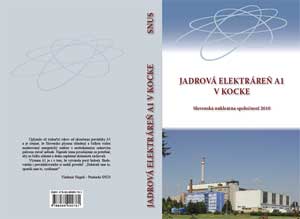
Why am I mentioning this book, which is written in Slovakian and, therefore, is readable by a relatively small Slovak and Czech nuclear community? The message is – when we seriously consider the nuclear renaissance, we should first know our history, learn about the first tentative steps that were taken. National nuclear societies are in fact capturing nuclear knowledge and competence and this book provides a positive example of their activities.
The ground-breaking 150 MW, CO2-cooled, heavy water moderated, gas-cooled Bohunice A1 reactor was developed in the late 1950s and first reached criticality in 1972. The project represented a big, bold step into the unknown. The principle of using natural uranium and doing away with expensive enrichment had never been tested before. Of course, as some of our older readers will remember, nuclear technology was in its infancy then and the A1 reactor suffered from a lot of technical setbacks and errors, based on understandable inexperience and a lack of modern computation models. How can you learn from the unknown? But these errors were ultimately to contribute to the project’s downfall. In the end, the nuclear community looked elsewhere, unconvinced that this reactor design option had a viable future. Looking at it today, it is easy to understand why, but it’s also easy to be wise after the event. Hindsight is a precious gift.
I’m sure that some readers can relate to what happened with the Bohunice A1 project. Research projects, like industrial projects, have their highs and lows and do not always follow the prescribed route – especially when knowledge and experience in a given area is limited. Success is never guaranteed. Funding can dry up and changing political objectives can alter the agenda. There can be great difficulties associated with any ambitious new project, some expected, others not. This is the reality that our friends at Bohunice encountered all those years ago. Even with the knowledge we have acquired today, unexpected problems still regularly occur. You can’t legislate for the unexpected, but to ignore the lessons of the past is unforgiveable. And that is the main message to be learnt from the story the book tells; the knowledge acquired from the past must be diligently transferred to the next generation of nuclear scientists, engineers and plant operators. Failure to do so is not an option. It’s about fundamental nuclear knowledge management. That knowledge, that substantial database of experience, must be a central part of the legacy passed on from generation to generation. If it is not passed on then we risk compromising the future. The errors that those involved in the Bohunice A1 project made were largely due to lack of knowledge and experience. With the knowledge we have amassed since then, we can’t so easily make the same excuse.
And this is where a knowledge-based nuclear society, like SNUS or ENS, can make a big difference; is making a big difference. The nuclear research community has a responsibility, one that it takes very seriously, to record, process and transfer that knowledge to current and future generations - just like SNUS has done in writing this book. By doing so, it is playing a crucial role in helping to ensure continuity and success for our industry in the future. This is part of the added value that ENS and its member societies have to offer. But we still have a lot more to do and the importance of this responsibility will never diminish.

Vladimir Slugen
President of ENS
http://www.euronuclear.org/e-news/e-news-30/listening.htm


As for many other large-scale human endeavours, the deployment of nuclear power plants has attracted interest from an historical point of view. But in contrast with most other industrial undertakings, the motivation behind such inquiries is not just to take stock of the progress made, but the hope to find in the past some general trends that could serve as a predictor of future behaviour. Three recent papers attempting to achieve this have attracted my attention. They were published by Nathan E. Hultman, Jonathan Koomey and Daniel Kammen1 [HKK for short], Arnulf Grubler2 [AG] and Mark Cooper3 [MC] in chronological order.
Aside from the history, these papers also offer an interesting story. Their common purpose is to draw attention to the nuclear industry’s weak point, i.e. its tendency to exceed construction time and budget. At the same time, they show that the commonality of purpose can nevertheless lead to papers differing widely with respect to the quality of the work performed. We’ll briefly summarise each of them and see that the quality of the research is heavily dependent on the extent to which it is ideologically driven.
The argument of HKK is quite simple. The authors went through the painstaking task of assessing the busbar cost of almost all US nuclear power plants in operation and ranked them according to increasing kWh cost, which gives rise to the following chart:
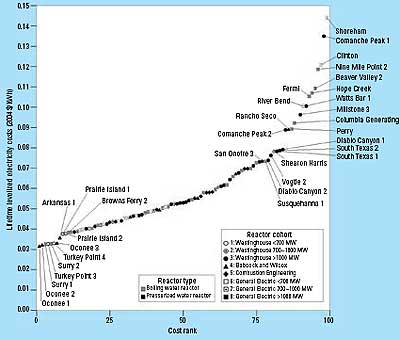
Without even delving in the details of the figure, it can be easily seen that the slope of the upper quartile (the right-most points) is noticeably steeper than that of the first three quartiles. If we take 80 USD/MWh (2004 value) as a cut-off value, a full 16% of the units represent a financial risk higher than what would be expected if the costs followed a normal distribution. The moral they draw from this observation is that the same could well occur again in the future when the construction of Generation IV reactors will be considered. HKK recognise however that the factors behind the general cost increase highlighted by the above figure include the lack of standardisation, public opposition and an increasingly demanding regulatory context. The role of the last of these factors is clearly acknowledged in the paper published in Energy Policy, e.g.:
Construction duration in the historical sample was influenced by a complex set of interrelated factors, including rapid regulatory changes (both before and after the Three Mile Island accident), quality control problems in construction, increased reactor size, reduced electricity demand growth, and utility financial constraints (…). (p 5634)
On the other hand, the authors point out that some vendors claim that future generation III reactors cost will be very low, actually low enough to equal or beat the best performing of the present reactors. Nobody can blame HKK when they consider that this cannot be done without further justification. Past performance is not bound to repeat itself in future but provides good enough a reason for explaining why things will be different next time. In the context of this observation, one might regret that HKK did not try to investigate further the case of the outliers their work highlighted. It might so happen that the circumstances that gave rise to them will indeed not apply in future (e.g. the US NRC’s new licensing procedures). In such case, the whole reasoning could have been made on an historical record from which the “fat tail” would have been removed and the conclusions might have been altered.
The tone of AG is at first deceivingly friendly since it starts with a positive appraisal of the French programme. But this is only an opening gambit to reinforce a much less positive conclusion: the French programme has been successful, but mainly so when you consider its initial phase corresponding to the construction its 32 first 900 MW units on the basis of an American licence. According to AG, everything started going awry when the French decided to increase the power of their units and to “frenchify” the design. AG goes even further by asserting that, in our changing world, the factors that permitted the past successes will not repeat themselves. The pro-nuclear reader would counter that the steady increase in design power that does indeed characterise the French programme goes hand in hand with a stiffening of the safety impositions of the regulatory authorities. But AG has foreseen the argument (p 27):
The reactor design changes undeniably improved safety features (…). But that was never a prime motivation for the changes in design and is therefore unlikely to be a significant factor in the cost escalation compared to the much more drastic and cost-consequential design changes aimed at [furthering the interests of the French players]. (Italics are mine)
Please note the presence of the words “never” and “therefore” in the excerpt quoted. The first of them goes against the evidence available everywhere: more stringent safety measures entail much more pervading design changes than does an increase in nominal power. The second word highlighted is conveniently introduced to convey a sense of necessary connexion between design motivation and its cost. This is tantamount to saying that, if improved safety is not a prime motivator for design changes, then the latter cannot be expensive. This is no more than idle speculation: which safety authority would tolerate vendors’ skimping on the safety measures it imposes? On the contrary, the veterans of the nuclear industry have witnessed that, at least from the 1970’s onwards, power increase was seen as a way of stemming the cost increases linked to ever more stringent regulatory requirements. In case the pro-nuclear reader had not yet absorbed the message, AG reinforces his point (p 32):
(…) while the nuclear industry is often quick to point at public opposition and regulatory uncertainty as reasons for real cost escalation, it may be more productive to start asking whether these trends are not intrinsic to the very nature of the technology itself: large-scale, lumpy, and requiring a formidable ability to manage complexity in both construction and operation.
I would like to suggest the following compromise: let the nuclear industry investigate more thoroughly the actual applicability of the law of economies of scale to the construction of nuclear reactors and let the critics of nuclear energy start considering the historical trend followed by nuclear safety regulations.
MC draws on HKK and, much more heavily, on AG to make his own case. The fact that he pursues AG’s denial of the impact of regulatory constraints to its logical conclusion shows in the way he performs a statistical analysis of the available cost figures relating to the French and American fleets of reactors. He submits a model (p 25) where the explanatory factors are supposed to be the reactor (model), the industry, the builder, and the construction period, all impacting the reactor cost. Some of these factors are further broken down to yield 10 different variables which are used to perform a regression analysis of NPP cost. Having performed the exercise, MC appears quite happy to state (p 27) that
“(…) there is little support for the learning and scaling up hypothesis at the industry level”.
No wonder: if you don’t leave any room in your model for regulatory requirements and public opposition, don’t expect to find any impact thereof in your results. In addition, the whole idea of explaining everything through regression analysis betrays in MC a kind of blind faith in figures. Forecasting the future appears to be only a matter of crunching numbers. The matter investigated is taken as a black box with the past as input and the future as output. Such approach reminds one of the Greek tragedies in which the protagonists could not escape a foretold destiny. Wouldn’t a look at the internals of the box really provide any useful insight? As to the absence of relevance of public opposition and changing rules of the regulatory game, both AG and MC should know better. The impact of these forces in the United States is well documented, not least by AG and MC’s own ideological friends who, in the 1960’s and 70’s were proudly recounting the legal battles the anti-nuclear were waging against the designs of the industry. In those days, it was a matter of showing how the little guys managed to successfully counter the moves of the big industry. Today, the priorities have shifted: the ideological stance consists in overlooking the fact that this ever happened so as to suggest that the nuclear industry’s purported woes are solely of its own making.
The lessons of the foregoing are quite straightforward:
On the one hand, the nuclear industry would do well to revisit its past record to better understand what is ascribable to increasingly stringent safety rules and what is not. This would enable it either to confirm its “moving target hypothesis” or to introduce into its cost models the factors, so far unaccounted for, that might counteract the hoped-for economies of scale.
On the other hand, we find one more time that the anti-nuclear are happy to settle for lame arguments and/or poor methodology. This brings us back to the eternal question: if one has good reasons for advocating a certain position, why should one resort to bad ones?
Andrew Teller
12 October 2010
1What history can teach us about the future costs of U.S. nuclear power, Environmental Science and Technology, April 2007. This article, available on the Internet, is a companion publication to a research paper titled “A reactor-level analysis of busbar costs for US nuclear plants, 1970–2005”, Energy Policy, 2007, which is not freely accessible.
An assessment of the costs of the French nuclear PWR program 1970 – 2000, Interim Report, International Institute for Applied Systems Analysis, October 2009; available on the Internet.
3 Policy Challenges of Nuclear Reactor Construction and Crowding Out alternatives, subtitled Lessons from the U.S. and France for the Effort to Revive the U.S. Industry with Loan Guarantees and Tax subsidies, Institute for energy and the Environment of the Vermont Law School, September 2010; available on the Internet.
http://www.euronuclear.org/e-news/e-news-30/pime2011.htm


The countdown to PIME 2011 has already begun. From 13 – 16 February 2011, nuclear communicators from across Europe and beyond will get together in Brussels, at the Thon Hotel City Centre (Avenue du Boulevard 17, 1000 Brussels), to take part in what has become the annual conference for nuclear communicators on the international events calendar.
As always, PIME offers participants a unique opportunity to brainstorm on the major communications issues and challenges of the day, to exchange experiences and expertise, to network with fellow professionals and to find collective solutions to shared problems.
The PIME 2011 programme is in the process of being finalised and will be posted on the ENS PIME 2011 website as soon as it is ready. In the meantime, here is a sneak preview of what you can expect in Brussels:
Day 1 Following on from the success of the PIME 2010 workshop on social media, and in response to popular demand, this year’s opening plenary session will be devoted to an extended analysis of the expanding world of blogs, Facebook and Twitter. The advent of social media and the power of the Internet have, in many ways, changed how journalists do their job and PIME will focus on how communicators must adapt their offer to the evolving needs of the media.
Another success from 2010 was the Communications Showcase, which will once again provide exhibitors with the chance to showcase their activities and get inspiration and useful tips from their fellow delegates. Let us know what kind of campaign materials you would like to have on display during the conference and we’ll take care of the rest.
Day 2 programme highlights include plenary session discussions on key issues like waste management and the highly sensitive issue of non-proliferation.
There will also be a plenary session on communicating new build and a number of parallel workshops.
Of course, PIME would not be PIME without the Conference Dinner and the presentation of the PIME Award for Communications Excellence. Once again the winning campaign will receive the recognition that it deserves… from PIME delegates themselves. Winning is all the sweeter when the recognition comes from your peers.
So, send in NOW the communications campaign that you would like to enter for this year’s award.
Mark the date in your diary, book your passage to the “capital of Europe” and make sure that you are part of the PIME experience!
For
further information about PIME 2011 please contact
Pime 2011 Conference Secretariat
www.pime2011.org
pime2011@euronuclear.org
http://www.euronuclear.org/e-news/e-news-30/rrfm2011.htm


The RRFM 2011 Programme Committee is calling for both oral and poster presentations regarding
This includes: Conversion to LEU fuels; Fissile material supply; Fresh fuel and targets: Origin and status, qualification, fabrication; Technical aspects of fuel in-core management and safety; Fresh and spent fuel transportation; Fuel and reactor licensing; Spent fuel storage, corrosion and degradation; Fuel back-end management.
Furthermore the Call for Papers extends to the following areas:
Innovative methods in research reactor analysis and design - Development and application of advanced computational methods and tools for research reactors physics, safety and fuel management; Neutronics Calculations and Experiments; Methods and Tools for Research Reactor Core Analysis and Design; Fuel Cycle Physics (including Actinides transmutation and proliferation reduction issues); Nuclear Safety Assessment Methods and Improvements for Research Reactors.
Utilization of Research Reactors – Research reactor services; Utilization experience and good practices; Success stories in improving research reactor sustainability; Utilization in the fields of research & development, education & training and industrial applications; Research reactors networks, coalitions and centres of excellence; Experiences in the transition from full government support to total or partial facility self-sustainability and self-reliance; Utilization in support of international initiatives on innovative nuclear power reactors and fuel cycles; Irradiation programmes carried out in research reactors in support of multilateral undertakings; Challenges, constraints and capability gaps potentially limiting research reactor’s utilization.
New Research Reactor Projects – National and regional plans for new research reactors; Lessons learned from building and operating new research reactors; Role of research reactors in developing nuclear competence to implement nuclear power programmes in a medium to long term perspective; Research reactor capacity needed to meet the future demand for radioisotopes for medicine and industry; Development of national and regional infrastructure necessary to implement new research reactor projects, including inter alia organization and management, uses and applications, funding and financing, stakeholder involvement, legislative framework, regulatory framework, nuclear safety, environmental protection, security and physical protection, safeguards and human resources.
Research Reactor Operation and Maintenance – Plant material condition control; Managing issues at either end of the facility 'bathtub curve' (commissioning, early operation and end of life/ageing related issues); Maintenance assessments and risk informed maintenance programmes; Management systems; Configuration management; Procedure utilisation; Communications and work control; Design review and control; Human resource development and training programmes; Regulatory interface; Public relations; Management improvement programmes and performance monitoring.
2011 TRIGA User Meeting - The 2011 TRIGA User Meeting will be organised as an embedded meeting within RRFM 2011. If you would like to actively participate in the 2011 TRIGA User Meeting by giving an oral presentation please upload a short abstract.
Authors should submit their abstract text in English through the reference number ISDN 978-92-95064-11-9 |
|---|
http://www.euronuclear.org/e-news/e-news-30/nestet2011.htm


NESTet is designed to facilitate an exchange of information and the sharing of best practice. It is an important networking opportunity for better co-ordination and collaboration between different stakeholders in nuclear education.
The NESTet Programme Committee is calling for papers regarding the following topics:
What are the needs with regard to nuclear education and training? Feed-back is thought from industry (operators, providers, suppliers, ..), regulators, safety authorities and research institutions on skills and profiles required to ensure an efficiently and safely performing nuclear sector. This includes all levels from undergraduate to PdD and from young professional to top management.
What are the answers that help to close the gap? This is all about sharing best practice and examples of co-operation between different stakeholders and about training and education programmes that are able to cover needs.
Where are efforts on harmonisation needed? Harmonisation is part of effective strategies for nuclear education and training. A range of well-known initiatives have been launched especially on university level and many of them have been discussed at NESTet 2008. Other areas still need attention and should be presented at this edition of NESTet.
How to increase the motivation of people for a career in nuclear? How to attract young people to the nuclear sector? How to encourage skilled professionals with general engineering or project management competence to join the nuclear sector? What do stakeholders offer to different levels from undergraduate to PdD and how do they integrate education and training in a career path?
What is the situation with regard to infrastructure and tools for nuclear education and training? How can we overcome bottlenecks where the required infrastructure is not available in sufficient quantity and quality? How can collaboration, sharing of facilities and new emerging tools ensure the provision of the required infrastructure? What is the role and importance of experimental facilities? How can we use new technologies for education and training (e-learning, simulators, virtual engineering…)?
What role for international co-operation? The nuclear industry is operating worldwide; education is based on national systems. How can we ensure highly skilled staff in all countries operating nuclear facilities? How can we learn from each other and get the best out of all systems?
The NESTet Programme Committee welcomes both oral and poster submissions. If you wish to share knowledge and best practice in nuclear education and training in science, engineering and technology, please submit your abstract by 31 December 2010 through the NESTet Abstract Submission System.
The abstracts received will be peer reviewed under the auspices of the NESTet Programme Committee. Authors will be notified of paper acceptance by 31 January 2011.
Deadline for abstract submission: 31. December 2010
Notification of authors: 31 January 2011
Deadline for full paper submission: 15 April 2011
Deadline for submission of PowerPoint presentations: 4 May 2011
Conference: 15 – 18 May 2011
Your full paper must be upload by 15 April 2011 at the very latest.
Your Powerpoint presentation must be in our possession by 4 May 2011 at the very latest.
![]() Download instructions for authors
Download instructions for authors
The proceedings NESTet 2011 will be published on the NESTet conference website, linked to the ENS website, with the reference number ISBN 978-92-95064-12-6
NESTet 2011 Delegates will receive a CD ROM with the proceedings of the conference about 6 weeks after the event.
Please don’t hesitate to contact the ENS / NESTet Secretariat should you have any question:
Tel: + 32 2 505 30 54
Fax: +32 2 502 3902
e-mail: nestet2011@euronuclear.org
www.nestet2011.org
http://www.euronuclear.org/e-news/e-news-30/onet.htm

We are delighted to announce that a new corporate member had joined the ENS family - ONET Technologies, from France.
For thirty years ONET Technologies, which is based in Marseille, has specialised in delivering its customers patented innovative technological applications aimed at enhancing the efficient operation of nuclear reactors and at providing a reliable and sustainable source of nuclear energy. It has provided technical expertise in a range of projects, such as the ITER project and others related to Generation IV reactor technology. The 2,200 engineers and technicians that work for ONET Technologies support their customers with continuous technical support and advice throughout the operational duration of the nuclear plants.
In France ONET Technologies is particularly renowned for its all-round expertise, most notably that relating to engineering, construction, reactor maintenance, decontamination, waste management, dismantling and training. Throughout its history protection of mankind and the environment against radiological risks has always been a watchword.
More information about our new ENS member can be found on the ONET Technologies website at: http://www.onet-technologies.com/fr/
Below is an interview with Dominique Mouillot, CEO of ONET Technology, which was published in the ENC 2010 Conference and Exhibition Guide.
ONET TECHNOLOGIES has offered its customers engineering and other types of services catered to the nuclear industry for the last 30 years. With a 20% increase in business volume, we have seen strong performance again this year.
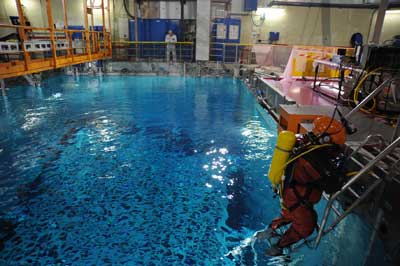
ONET TECHNOLOGIES is a leading player in the dismantling and decommissioning and waste management sector. It is currently overseeing major contracts such as the dismantling of the Brennilis nuclear reactor block, which is the first reactor to be dismantled in France.
We are the top company for nuclear logistics and radioprotection for the French nuclear fleet.
We have fostered a culture of innovation in order for our teams to develop customised solutions that allow us adapting to the specific demands of international markets. This strategy has helped us obtain strategic dismantling and waste management contracts in Bulgaria, Ukraine and Romania in 2009.
Our international development is supported by our network of subsidiaries including ONET TECHNOLOGIES BULGARIA, ONET TECHNOLOGIES ROMANIA, ONET TECHNOLOGIES ITALIA, ONET TECHNOLOGIES UK – GRAVATOM, and we are currently in the process of launching ONET TECHNOLOGIES SLOVAKIA.
We are proud to have accomplished several successful commercial achievements in the nuclear maintenance sector.
For instance, as part of the EDF contract, with our partner, CCI Sulzer, we will be responsible for twelve of the twenty-eight work batches in the call for tenders to replace fuel racks for fuel building pools. This contract provides business prospects until 2017.
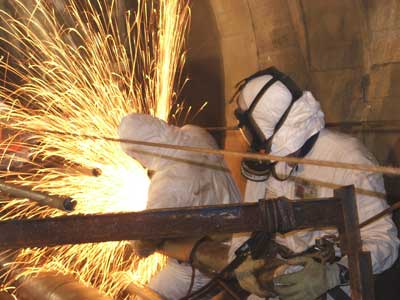
In partnership with COMEX NUCLEAIRE, MITSUBISHI HEAVY INDUSTRIES was awarded a contract to supply three new Replacement Steam Generators (RSG), which brings us to fifteen contracts in four years.
We were also awarded, along with our partner, LAINSA (DOMINGUIS Group) a contract to develop preventive cleaning processes for Steam Generators.
In 2010, we continue our investments in human technical resources in order to provide solutions for all of our customers’ major projects.
Our teams are fully equipped to submit tenders for future contracts in the power reactor maintenance field, with the supply of large components and full installations such as the Machinery Room for the EPR which this entails.
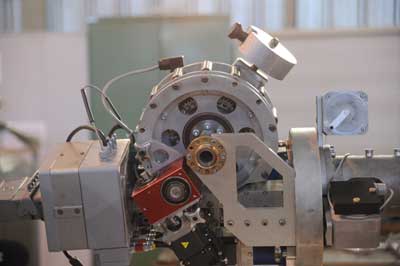
We will continue to strengthen our leadership in decommissioning, dismantling, and waste management trades.
Our ability to develop on an international level remains one of our strategic focuses. Spain, India and the United States are currently our main geographic targets.
As part of our dedication to finding solutions for the future, we are actively involved in projects such as ITER and Generation IV reactors, which in the long term, will revolutionise the world energy landscape.
ONET TECHNOLOGIES – 36 Bd de l’Océan, CS 20280, 13258 Marseille cedex 09, France – www.onet-technologies.com
http://www.euronuclear.org/e-news/e-news-30/temelin.htm

In September a highly significant event took place at the Temelin NPP, in the Czech Republic – the first spent fuel container was placed in interim storage there. To mark the occasion, CEZ sent the following press release, which generated considerable subsequent press coverage.
“In terms of construction, technology and legislation the storage is prepared to start the annual trial operation. We shall place one or two spent fuel containers from every unit to the storage every year,” says Miloš Štěpanovský, director of the Temelín NPP. “Two containers contain spent fuel, which produced 7 billion kWh of electrical power during one campaign. The volume of two CASTOR containers used at the Temelín NPP is only a total of 46 m3.”
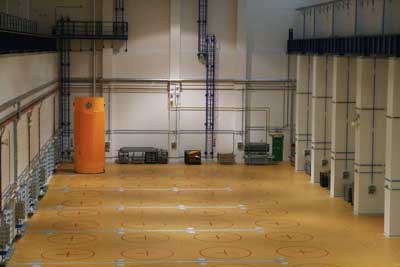
Due to the fact that a nuclear power plant does not produce any emissions of carbon dioxide during production, such an amount of electricity means savings of 7 million tons of this greenhouse gas.
The storage capacity is 1,370 tons of uranium, which represents spent fuel for the 30-year operation of the Temelín NPP. Such an amount of fuel fits in 152 CASTOR containers placed in storage halls. The CASTOR containers were manufactured and delivered by GNS, the German manufacturer. “Placing the spent fuel in storage containers is the most frequent way of storing spent fuel. It is a safe and controlled technology without any effect on the environment. In the Czech Republic we have already had 15 years of experience with this type of storage from the Dukovany NPP, where two storage containers have been in operation.” Jan Coufal, Manager of the ČEZ Spent Fuel Storage project team describes his experience of spent fuel storage.
Nineteen fuel assemblies fit in every container used at the Temelín NPP. These steel containers create the main barrier between spent fuel and the environment “They are strictly tested before use and their quality is consequently certified by the issue of a licence by the State Office for Nuclear Safety which permits their use in the Czech Republic” Mr. Coufal adds.
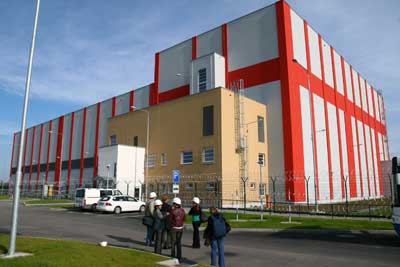
Spent fuel can be kept in the containers for up to 60 years. Spent fuel reprocessing technologies are already known in the world. According to the valid State Energy Concept, the Czech Republic takes the line of temporary storage as a way of permanent repository. The ČEZ company does not consider spent fuel to be a waste product, but a precious power source which can be reused in future, not kept in a repository. “Just four per cent of fuel is used in the reactor. Therefore, we can see spent fuel as having an important power potential for the future. Reprocessing technology already exists to enable spent fuel to be reused. In Europe such technology has already been used in France and England. Its high cost prevents its extension. Due to the estimated rise of uranium prices on world markets such technology will become an interesting alternative for power companies” Miloš Štěpanovský, Director of the nuclear power plant, explains the possibility of the further use of spent fuel.
The spent fuel interim storage unit is a reinforced concrete building, which consists of a receiving and storage section. The storage building is resistant to "external extreme natural effects" (seismicity). A hypothetical crash of a large airplane has been analysed within the EIA process. From the conclusions drawn no radiation accident should arise.
The plan to build spent fuel storage on the premises of the Temelín nuclear power plant has gone through a very difficult procedure, in which the neighbouring countries of Austria and Germany have also been involved for the first time in history. During the legislative proceedings the Ministry of Environment issued a positive EIA opinion. The State Office for Nuclear Safety permitted the construction in terms of nuclear safety. A special expert committee of the European Union also assessed the storage. The investor was awarded positive opinions in all administrative actions. ČEZ received the final building permit in February 2009, i.e. after 5.5 years of administrative preparations. The length of permit procedures for similar projects in the Czech Republic is among the longest ones within the European Union. For example, an approval process for a nuclear power plant in Flamanville took less than two years.
History of the permit procedure of the Spent Fuel Storage at Temelín NPP
Preparatory legislative step |
Date |
Information on the plan and start of the Environmental Impact Assessment (EIA – international). |
21 July 2003 |
Public discussion on EIA-České Budějovice. |
24 August 2005 |
Positive opinion of the Ministry of Environment of the Czech Republic on EIA. |
28 November 2005 |
Consent of EU commission in terms of eliminating the cross-border effects of the construction. |
24 November 2005 |
Positive opinion of the State Office for Nuclear Safety regarding location of storage. |
29 December 2005 |
Submitting an application for a zoning and planning permit to the Construction Office. |
21 April 2006 |
Regional Authority of South Bohemia issued a positive zoning and planning permit. |
25 October 2006 |
Ministry cancelled the decision and returned it to the Regional Authority of South Bohemia to discuss it. |
21 March 2007 |
Regional Authority of South Bohemia issued a second positive zoning and planning permit. |
24 August 2007 |
Ministry cancelled the decision and returned it to the Regional Authority of South Bohemia to discuss it. |
24 January 2008 |
Regional Authority of South Bohemia issued a third positive zoning and planning permit. |
14 April 2008 |
Ministry rejected all cancellations and approved the decision of the Regional Authority. |
18 July 2008 |
The zoning and planning permit became valid. |
23 July 2008 |
The State Office for Nuclear Safety issued a building permit; the State Office for Nuclear Safety assessed the construction in terms of physical protection, nuclear safety and radiation protection. |
August 2008 |
Submission of an application for a building permit to the Ministry of Industry and Trade. |
4 September 2008 |
The Ministry of Industry and Trade issued the building permit. |
11 November 2008 |
Emergency planning zone association at Temelín NPP appealed against the decision. |
24 November 2008 |
The Minister of Industry rejected the appeal and approved the validity of the building permit. |
12 February 2009 |
The building permit became valid. |
23 February 2009 |
Construction started. |
4 February 2009 |
First CASTOR container was placed in spent fuel storage. |
8 September 2010 |
Trial operation of spent fuel storage started. |
9 September 2010 |
Marek Sviták
Press Agent of the ČEZ Group
Temelín Nuclear Power Plant
http://www.euronuclear.org/e-news/e-news-30/SKB.htm

On 30 September, Sweden’s national nuclear fuel and waste management company, SKB submitted its latest R&D programme to the Swedish Radiation Safety Authority (SSM). Under Swedish law SKB is required to provide SSM with regular three-yearly updates on the results of its current research programme, as well as details of its future research plans. The data it has submitted forms the basis of its application for a permit to build a final repository for Sweden’s spent nuclear fuel in Forsmark, in the municipality of Östhammar, north east of the capital, Stockholm. The final application will be submitted to SSM and to Sweden’s Environmental Court in March 2011. If the application is approved by the authorities construction of the nuclear fuel repository can be started in 2015 and disposal operations in 2025. This application represents the culmination of more than 30 years research into the feasibility of building such a repository in Sweden.
Before any application could be submitted the requisite public support for the project had to be obtained. A recent survey showed that 80% of the approximately 21,000 inhabitants of Östhammar municipality, which already hosts one of Sweden’s nuclear power plants, declared their support for having the repository located in their midst - a clear case of “yimby” or “yes, in my back yard.”
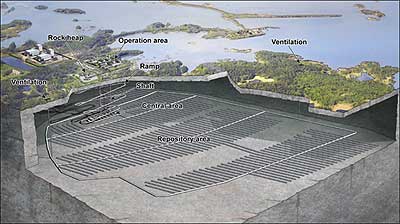
Plans for the spent fuel repository at Forsmark, north of Stockholm
SKB is also developing plans for the management and disposal of low and intermediate-level radioactive waste, and intends to submit an application to extend the capacity of the existing final repository for short-lived radioactive waste (SFR). The extended facility, if the application is successful, is expected to become operational in 2020.
For more information about the application for the spent fuel repository consult SKB’s press release at:
www.skb.se/Templates/Standard____29896.aspx or click on the following link: www.skb.se/Templates/Standard____28848.aspx
Editor-in-Chief
http://www.euronuclear.org/e-news/e-news-30/paks-npp.htm
The following article giving extensive details on the tender process for the two new nuclear units at Paks NPP, in Hungary, was published in a special issue of Technika magazine, a leading Hungarian scientific journal. ENS NEWS felt it ought to bring it to the attention of its readers. The article is available on the ENS website at the following link: more
Editor-in-Chief
http://www.euronuclear.org/e-news/e-news-30/research-reactor.htm

On 20 September, two ENS corporate members, SCK-CEN (the Belgian Nuclear Research Centre, in Mol) and NRG (the Nuclear Research and consultancy Group, in Petten, Netherlands), joined forces with the CEA (the Commissariat à l’Energie Atomique et aux Energies Alternatives, in France) to sign a position paper setting out the establishment of the European Research Area of Experimental Reactors (ERAER). This ground-breaking document is a statement of collective intent and a detailed road map determining the way forward for Europe’s nuclear research reactors.
The position paper, which was signed during the General Assembly of the Sustainable Nuclear Energy Technology Platform (SNETP), is based upon current infrastructures and projected needs, as identified by the signatories. It proposes a consistent policy for the operation of Europe’s experimental nuclear reactors that takes account of the very latest technology and is in keeping with the Strategic Research Agenda (SRA) of the SNETP. As the SRA clearly states, Europe will only be able to hold on to its position of worldwide leadership in research reactor technology if it establishes a research area specific to research reactor technology - the ERAER. The ERAER is based upon the operation of three main research reactors:
the Jules Horowitz Reactor (JHR) at the CEA’s facilities in Cadarache, France: the JHR addresses industry’s requirements in the field of materials testing and fuel performance analysis for Generation II and III reactors, as well as generic research for Generation IV reactors.
the MYRRHA reactor, at SCK-CEN in Mol, Belgium: this is a flexible fast irradiation facility that operates as a sub-critical system and a critical reactor for material and fuel testing for Generation IV and fusion reactors. It is also used as a back-up reactor for medical radioisotope production.
the PALLAS reactor at Petten, in the Netherlands: when built (it is currently being designed) the Pallas thermal spectrum reactor will replace NRG’s High Flux Reactor (HFR). It will ensure continuity for the vital production of medical radioisotopes for Europe, thereby supporting industrial applications.
The signing of this ERAER position paper is highly significant because it should provide for optimal exploitation of Europe’s existing material and fuel testing capability. This will, in turn, support reactor safety, optimised plant lifetime management and future reactor design and innovations. The development of a fast spectrum irradiation facility (PALLAS) will further enable Europe to stay one step ahead of the rest of the world when it comes to nuclear research reactor technology. At the same time, by supporting the production of the medical radioisotopes that Europe’s hospitals so badly need the new road map will help provide an essential public health service for European citizens.
The three signatories of the ERAER position paper were clear in their support for and promotion of this joint initiative:
Rob Stol, Managing Director of NRG, in Petten, emphasised that: “The position paper is of great importance for the future of the application of nuclear technology in both power generation and nuclear medicine. The three research reactors will play a crucial role in the qualification and testing of fuel and construction materials for existing and future reactors. Security of supply of radio isotopes for nuclear medicine is also a challenge since the old research reactors that produce these materials have to be replaced in this decade. The position paper expresses the common will to cooperate in these areas.”
Christophe Béhar, Director of Nuclear Energy at the CEA added that: “The nuclear revival has led to a new source of dynamic competition in this field. The setting up of a European research area for research reactors is undoubtedly of capital importance if Europe wants to remain a world leader in this domain.”
Eric Van Walle, Managing Director of SCK-CEN added: “This agreement is the fruit of a common commitment to maintain at the very highest level all acquired knowledge with regards to nuclear research in Europe. Going beyond national boundaries and taking into account the important context of sustainable development, the three partners have put at society’s disposal research tools.”
To have a detailed look at the ERAER position paper and the joint press release, click on the following links:
You can also find more information from the web sites of the three signatories: www.cea.fr ; www.sckcen.be and www.nrg.eu
http://www.euronuclear.org/e-news/e-news-30/aren.htm


An important event for the nuclear sector in Romania took place on October 22: the celebration of 20 years of activity of the Romanian Association for Nuclear Energy (AREN).
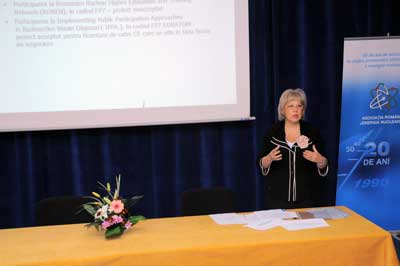
It was a small family celebration that included several messages, lots of memories and a few little surprises.
AREN was founded in 1990, during a period of great hope, expectations and plans for the future, after the fall of the communist regime in Romania. However, the nuclear programme in Romania had already started several decades earlier, under communist control. Romanian scientists were world-renowned for their progress in the field and by the time the democratic regime came into power in Romania, they rallied in a non-governmental organization aimed at promoting nuclear energy. The purpose of the Association was clear from the beginning as there was a challenge to be met - the nuclear sectoreld had to survive, to get funding and develop.
The Association is made up of individual members from nuclear companies and organisations in Romania, who work for it on a voluntary basis. Currently, AREN has around 200 members.
The nucleus of the Association consisted of young and determined engineers and researchers who realised the importance of nuclear power for Romania’s future. The Association’s objectives included promoting the peaceful use of nuclear energy, informing and educating the population, supporting the national nuclear programme, improving safety culture and exchanging ideas and experience with international agencies.
In 1991, AREN became affiliated to the European Nuclear Society (ENS) and started to organise events and conferences on an increasing scale since 1993. One of the most prominent and long-established activities of the Association is the organisation of the International Symposium for Nuclear Energy, which is held in Bucharest every two years.
During two decades of activity the involvement of the Association became more visible and its actions have diversified to include focusiing on more areas of the general public, such as children, pupils and students, women etc. The Association also represented a model for the brilliant minds of the time, granting support to young engineers and researchers in Romania to complete their career and publish their works.
AREN has two branches: Women in Nuclear, affiliated to WiN Global, and the Young Generation Network, which is also recognised within the international network.
The anniversary celebrations organised on October 22 at the Politehnica University of Bucharest represented an opportunity that many Romanian scientists, professors, business men embraced as an occasion to get together and revive their memories about the history of the Association. Speeches were given by prominent members of the Association, who expressed their confidence in the future of nuclear power in Romania and pledged their continuous support for the industry. The presidents of the major actors involved in the nuclear field - the Regulatory Body (CNCAN), the Nuclear Agency for Radioactive Waste and the University Politechnica of Bucharest - delivered their messages of congratulations and also thanks for the great involvement of AREN in promoting the Romanian nuclear energy sector.
A brief review of the main events that have taken since December 1, 1992, first performed under the title "Days of Romanian nuclear power " and including the 2010 events was provided in an art exhibition.
The President of the Association, Mihaela Stiopol, encouraged the young generation and concluded that nuclear is the “tip of the sword” …. In the future, the Association plans to develop more lobby activities and have a bigger influence upon the authorities. It also plans to continue its’ activities dedicated to informing the young generation and promoting nuclear power with the general public. Alongside the anniversary conference, AREN exhibited children drawings from the various contests that were organised organized in the previous years by the Association.
http://www.euronuclear.org/e-news/e-news-30/westinghouse.htm

|
Westinghouse marked a major milestone in the Chinese AP1000 construction programme in June when the concrete basemat was successfully laid at the last of the four AP1000 units being built there. This means that all four plants are now officially “under construction”, and all are on or ahead of schedule. In fact the basemat concrete pour at Haiyang Unit 2 was six weeks ahead of schedule – evidence of the value of series build, as the second, third and fourth plants have been reaping the benefits of lessons learned on the first plant – Sanmen Unit 1. |
|---|
At that lead plant – Sanmen 1 – progress has also been notable, with the third ring of the containment vessel set in place in September (see pictures). That plant remains on track to produce electricity for the Chinese grid in 2013. The China projects have a strong bearing on new build in Europe. Potential customers for the AP1000 in countries such as UK, Czech Republic and Poland, are watching closely as the on schedule performance in China (hopefully followed by similar success in the US) helps to give them confidence that AP1000 plants can be built on time in their own countries.
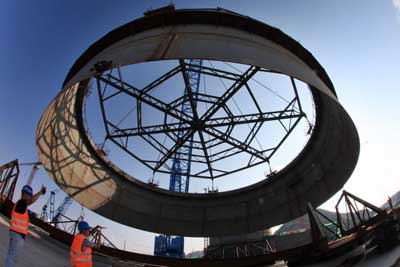
Westinghouse’s operations in Europe now account for around 30% of the company’s global turnover, and a similar proportion of the company’s employees are based in Europe. With that in mind, Westinghouse announced in the summer that the company is moving to a more regional-based way of working, and has established a new regional headquarters in Brussels under the leadership of Anders Jackson, who has been appointed Westinghouse President for the Europe, Middle East and Africa region.
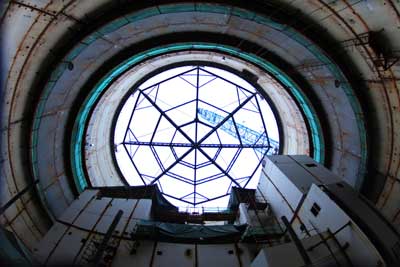
Adrian Bull
Head of Stakeholder Relations
Westinghouse UK
http://www.euronuclear.org/e-news/e-news-30/enusa.htm

Since 1985, one of the most valuable business assets in the province of Salamanca has been located in a small town called Juzbado, around 30 kilometers from the provincial capital: the nuclear fuel factory of Enusa Industrias Avanzadas, S.A.

Highly-professional and able to undertake complex engineering projects, the factory has the necessary flexibility to understand and respond to market requirements and the know-how and resources needed to produce the first-rate products it demands. Enusa also implements an openly customer-oriented policy. All these contributing factors have helped the Enusa factory to develop major assets that have enabled it to gain a leading position in the complex market within which it operates. It is often said that the hardest thing is not to get there, but rather to stay there. Well, Enusa is currently facing a major challenge – fulfilling its responsibility to respond to its customers’ trust by maintaining the highest standards of quality, reliability and safety both with regards to its operations and to the products and services that it provides.
The European nuclear market is a mature market in which Enusa has succeeded in achieving a privileged position. The first fuel supply contract for the Swiss Leibstadt power plant in 1988 is now part of history, but it represented a one-off approach to the outside world because at the time output from the Juzbado factory was exclusively intended for the national market. Little by little, however, the volume earmarked for exporting grew until exports reached their current level, equivalent to more than 70% of the factory’s total production. The rest is destined for Spanish nuclear power plants.
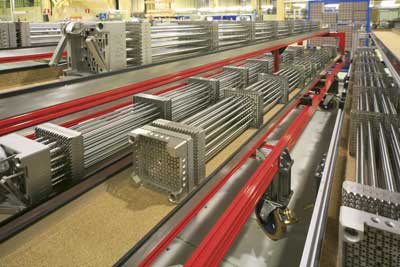
This access to the European market meant that Enusa had to adapt its operations to conform to a framework of new regulations, requirements and regulatory authorities. Mastering this new framework was decisive in helping the company to develop its competitive capacity with an eye for the future and accomplish significant outcomes, such as the licensing of in-house developed design codes by European regulatory bodies.
In this respect, it should be noted that Enusa allocates 6% of its fuel sales to R&D. This allows it to continuously invest in equipment upgrading or in programmes aimed at developing its manufacturing processes, as well as take part in international nuclear projects in collaboration with licensors, regulatory bodies, customers or other companies with which it has technology-based partnerships.
Enusa’s international vocation was born in the early years of its business activities and today the company supplies fuel to countries such as Finland, Sweden, Germany, Belgium and France (in addition to seven of the eight national reactors), thanks to the current nuclear revival. Enusa is positioning itself in new markets through strategic alliances that are helping it to grow and optimize its resources, whilst at the same securing positions in the emerging markets. The most representative example of this is the Spanish Nuclear Group for China, a partnership of four Spanish nuclear enterprises whose objective is to compete in the difficult Asian market. In this way, by focusing on the emerging markets such as China, Enusa has taken the implementation of its international strategy another step forward.
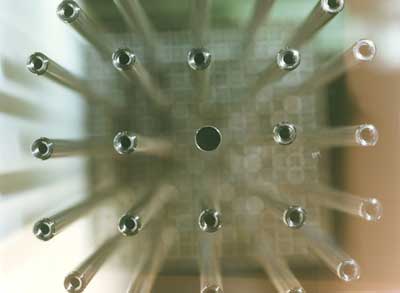
2010 has been a good year, not only because of the operating figures, but also because it marked a very special occasion for the Enusa factory. The facility has celebrated not only its 25th anniversary but also the fact that, for the fourth year in a row, it set an annual production record, with 326 tU (tons of uranium) produced in 2009. It has thus managed to exceed the figure of 5,000 tU produced since it began operations in 1985 and has now obtained a license for producing 500 tU/year.
This hard working factory will devote its future efforts to maintaining the current level of production and producing between 400 and 500 tons per year. The Enusa factory’s existence for a quarter of a century, coupled with the position that it occupies on the front line of its business sector demonstrate that, although it is a hard road to travel, in the Salamanca town of Juzbado they know how to do things safely and well.
http://www.euronuclear.org/e-news/e-news-30/SNE-news.htm

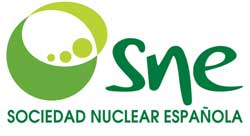
The Annual Meeting of the Spanish Nuclear Society held in Santiago de Compostela, in October, was once again a success. The number of delegates who participated was over 560, and in addition there were over 100 accompanying guests, making a total attendance of about 700 people. Among those participating were around 30 corporate sponsors and 34 exhibitors.
The meeting agenda featured 29 technical sessions and 266 papers. Of the 29 sessions all bar one were oral ones – the exception being one poster session. In addition, monographic sessions took place on such interesting topics as "Science and Technology Development at CERN," "New Developments in Inspection and Materials Technology" and "European Initiatives on Nuclear Energy."
Courses have been completed aimed at encouraging the exchange of information and knowledge on topics like "Liberalisation of Gas and Electricity in Spain," "Experiences and Impressions of the Nuclear Youth members at Chernobyl" and "Management of Design Modifications in a Nuclear Power Plant."
Among the social events on the agenda of the Annual Meeting that warrant special mention were the gift to the Apostle Santiago that was presented on behalf of the SNE by our President, and the Medal of the Society that was awarded to José Luis González, president of ENUSA, who throughout his well–known career has always provided invaluable support to the activities of SNE.
The Nuclear Youth Generation once again organised its "Basic Course in Nuclear Science and Technology", which this year benefited from the collaboration of EPRI (Electric Power Research Institute), and institutional support from the University of Santiago de Compostela (USC). Women in Nuclear (WiN) organised a conference on "Energy Saving and Efficiency", showing the increasing need to optimise our energy consumption, taking into account that energy is a finite commodity that we cannot afford to waste.
The main focus of the meeting was the future of energy in our country and the world. It is noticeable how developed countries and emerging economies are making decisions regarding medium to long-term energy planning. These include decisions on the role of nuclear energy as part of the energy mix in their countries, thereby prolonging the operation of their power plants - as was the case recently in Germany. Other decisions involve new build planning. The point of view of SNE is that Spain cannot escape this reality.
This year the meeting centred around three plenary sessions. The first one was devoted to "Nuclear Energy Advertising in Spain and the World." The session presented the aspects that determine the success or failure of communications campaigns, and why it is that the messages that are communicated reach the public more easily in some countries than in others.
The second plenary session was devoted to the "Ibero-American Nuclear Programme", and featured the presence of leading speakers from Argentina, Brazil and Mexico. It highlighted the current situation and future plans of the nuclear industry in those countries. It also illustrated the reasoning that has guided their decisions on energy planning, decisions that were reached having taken into account various potential scenarios, and bearing in mind their objective of achieving the greatest possible consensus to ensure stability in the medium and long-term.
The third plenary session was devoted to the relationship between the "Energy and the Electric Vehicle", showing not only the opportunities that the development of these vehicles can offer, but also the risks they pose for the generation and distribution system.
In addition to the plenary sessions, there were a number of presentations highlighting the latest technologies used in our industry. These were included within the broad programme of technical sessions and included discussions on such issues as nuclear safety, fuel, radioactive waste, nuclear medicine and radiation protection. Special importance is given to research and development that aims to promote the continuous improvement of the operation and maintenance of our plants, as well as the participation of the Spanish industry in the new international projects.
The 37th Annual Meeting will be held next year, in October, in the city of Burgos. It will coincide with the 40th anniversary of the Central Nuclear de Santa María de Garoña.
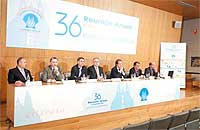 |
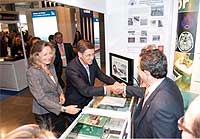 |
|---|---|
|
|
Miguel Millán, president of Spanish Nuclear Youth Generation has been elected President of the International Youth Nuclear Congress Network, replacing Hans Korteweg (FORATOM).
Presidency changes have occurred in three committees (WiN, Nuclear Youth Generation and Programmes), thereby ensuring the continuity of SNE.
All representatives of the energy sector in Spain claim that an agreement on energy has been reached by the two major parties, the PSOE, now in government, and the PP, in opposition. These parties have agreed upon the upgrade of the electricity bill and attempts are being made to reach a consensus for a long-term pact to determine the energy scenario in 20 or 25 years. This would allow the Spanish energy sector to plan more effective and stable strategies for growth and development.
The Committee responsible for choosing the location for the Centralised Temporary Storage (ATC) of nuclear waste has presented a report to the Council of Ministers, in which Zarra (Valencia) received the best rating (Ascó, Tarragona, came second). The report does not prejudice any individual candidate’s chances of winning, but instead carries out an assessment according to several criteria, so that the Council of Ministers can make its final decision. The government postponed its final decision after receiving the results of a new report referred which it refers to the state’s legal services.
http://www.euronuclear.org/e-news/e-news-30/ats.htm

On 21 September, in Säätytalo, Helsinki, Leena Jylhä from Prizztech Oy presented the activities of the FinNuclear network to ATS members at their latest meeting. A total of 26 members participated.
The FinNuclear network started its activities as a part of the Energy Cluster within the National Center of Expertise Programme. This programme aims to promote the improvement of competence and of business opportunities for the Finnish energy industry. Nuclear technology is one of the programme’s main focus areas.
The company PrizzTech Oy co-ordinates the work of the FinNuclear. Finnish utilities like Fennovoima, Fortum & TVO, as well as industrial companies like Pöyry, Dekra, Telatek, Hollming, Outokumpu, Kraftanalage Arge OL3 and Wärtsilä, all participate in the network’s Co-ordination Group. The Energy Technology Cluster Programme, the Federation of Energy Industries, the Federation of Technology Industries, the Ministry of Labour and Industry and the VTT also participate.
The presentation of Leena Jylhä is available, in Finnish, on the ATS web-site: (www.ats-fns.fi/archive/esitys_jylha_2010.pdf). Information in English about the network is available via the following link: www.finnuclear.fi .
The activities of the ATS-seniors continued with a visit to VTT in Otaniemi, Espoo. VTT is a national research center with nearly 3000 employees, of which about 200 work full- time in the nuclear field (www.vtt.fi/?lang=en). Altogether, 15 seniors participated in the event. One of the laboratories visited was the experimental facility for the testing of deforming and hard missile impacts against concrete structures (see Fig.1).
The coming events of ATS-seniors include a common seminar with ATS Young Generation, entitled: "Atomic power for Finland". This seminar will be take place on 17 November, in Säätytalo, Helsinki.

Fig. 1: The IMPACT test rig, at Otaniemi
The ATS-seniors visited the IMPACT test rig at Otaniemi. Click on the following link: (virtual.vtt.fi )
Erkki Laurila Award presented to Pertti Siltanen and Elja Kaloinen
Pertti Siltanen and Elja Kaloinen received the ATS’ annual Erkki Laurila Award for their paper "HEXBU-3D -programme: description of the neutron flux in the core of a VVER-reactor". Since 2001, the Erkki Laurila Award has been given to the best scientific paper published in Ydintekniikka - the magazine of the Finnish Nuclear Society. The article selected was published in the first issue of the magazine, back in 2009.
The article was selected by the editors of the magazine and the choice ratified by the board of ATS. Explaining their decision the editors stated "The paper of Mr. Siltanen and Mr. Kaloinen is a description of significant development work carried out by two experienced Finnish specialists. The results of this work are widely used today, for example in the design of the reloads of Loviisa NPP. The high-level scientific work behind the development of HEXBU-3D - code is also very creditable".
The closure head of the Olkiluoto 3 reactor pressure vessel has been lifted inside the reactor building. The introduction of the main reactor island components of Olkiluoto 3 unit was continued on 30 November. This time the closure head of the reactor pressure vessel, weighing 90 tons, was lifted inside the reactor building. The closure head is waiting on a storage rack for its final placement on top of the pressure vessel. The rack is the same during outages. Just like the pressure vessel, the closure head is made of forged ferrite steel and clad with stainless steel on the inside to prevent corrosion.
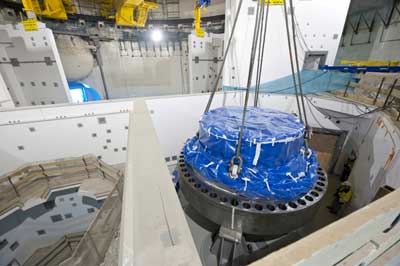
Fig. 2: The closure head of the Olkiluoto 3 reactor pressure vessel
Source: TVO (www.tvo.fi/www/page/3476/ )
http://www.euronuclear.org/e-news/e-news-30/hns.htm

The future expansion of the nuclear industry requires a constant supply of qualified professionals. In Hungary, hundreds of workers at the Paks NPP are going to retire over the next ten years and many will need replacing. The life extension of a nuclear power plant, as well as the possible building of other plant units, requires additional professionals. This view is supported by the fact that in Finland the decision that led to the building of new units increased tenfold the number of the university students choosing to study nuclear energy.
The need to strengthen the training and education of nuclear professionals and provide further education for talented individuals had already become apparent several times before the spring of 2007, when the idea to organise a nuclear summer camp first came about. The organisation was carried out by the management of the Hungarian Nuclear Society (HNS) with the help of the society’s group of teachers and students (Youngsters for Nuclear Energy - YNE). The summer camps were supported by Paks NPP. The Eötvös Loránd University, and Budapest University of Technology and Economics also provided great help with the organisation of the measuring and monitoring tasks.
To reach the overriding goal – to motivate students to want to study nuclear technologies – the organisers created diverse, high-quality educational programmes, while at the same time emphasising the importance of receiving a good basic theoretical and practical education. Lectures were given by scientists, university professors and researchers. In addition to these lectures from experienced experts, the programme also featured computer simulation exercises and measuring and monitoring experiments. Despite the tight schedule students also had an opportunity to relax and to visit nuclear facilities.
At the summer camps teachers, young scientists and students took care of participants. At the end of the camps participants received certificates, t-shirts and CDs featuring the materials from the lectures and photos taken at the camp.
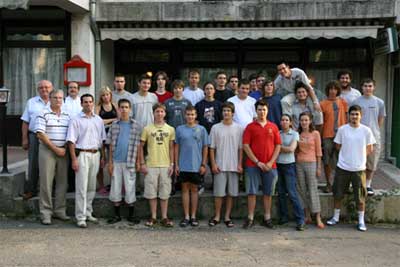
Participants of the first Nuclear Summer Camp (2007)
In June 2010, the fourth Nuclear Summer Camp took place. These one week long camps - in which high school students from all parts of the country participated - were located in the neighbourhood of Budapest because of the easy access it affords.
In these four years since the first camp was organised there have always been a number of returning students, as well as first-timers. One student has taken part in all four camps. Consequently, the programmes were devised for both beginners and advanced students.
On the first day of every camp the “beginners” were taught the basics of nuclear physics. We wanted to avoid repetition and so different aspects of the same topics were presented. In addition, lectures also featured well-known adaptations of nuclear measurement techniques. After teaching the basic notions of the measurement techniques, the measurement tools – those which are suitable for detecting radiation – were explained. Experts talked about many things from basic neutron-physics to the difficulty of detecting the neutrinos. At the first camp, students could follow the research of CERN via a videoconference link. They had the opportunity to talk to Hungarian scientists working there. Furthermore, every year’s programme included lectures about particle physics.
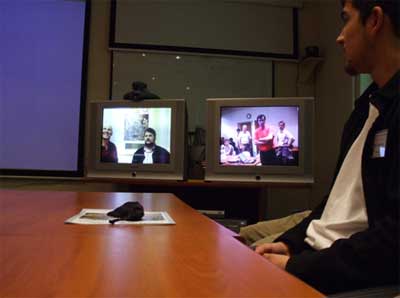
Videoconference with CERN (2007)
In addition to these programme elements there were many current issues to talk about. The invited experts reported on the increasing importance of climate change, the difficulties associated with the various ways of using renewable energy sources and the national and international nuclear energy scene. There were also lectures about the capacity increasing programmes of the nuclear power plants, service lifetime extension, the accident at Paks NPP and the experiences learned from it and safety questions relating to nuclear reactors. The students also were given information about the storage of domestic nuclear waste and the possible location of the European Spallation Source (ESS) facility in Hungary.
Participants also listened to lectures about additional applications of nuclear technology, including the relationship between nuclear technology and material science, the various methods of analysing materials, the medical usage of radioisotopes and the military use of nuclear energy. Lectures about the magnetic confinement of plasma and about the ITER (International Thermonuclear Experimental Reactor) programme provided information about the most successful research projects that have focused on fusion and about its possible applications. A lecture on the thermo-luminescent dosimeter (TLD), which was developed by The Hungarian Academy of Sciences and the KFKI Atomic Energy Research Institute, was much appreciated because it used material gathered by Charles Simonyi Jr. during his mission in space. At every summer camp lectures on the history of science were also given.
The lectures were followed by study trips. During the four years since the summer camps’ creation participants have taken part in visits to the Paks NPP and KFKI. These provided them with a chance to see the research reactor and training reactor there.
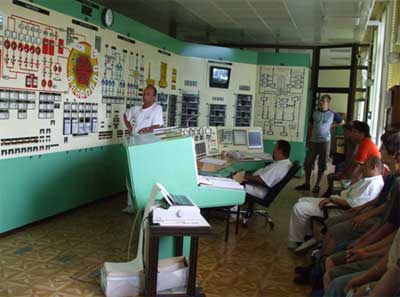
Study trip to the research reactor in KFKI (2007)
Each year, participants have also visited Eötvös Loránd University, where after the lectures, they had a look at the nuclear astrophysics and chemistry laboratories, where they got acquainted with the recent research activities carried out there.
In the second year, students visited the low and high-level radioactive waste disposal facility. The students were impressed by having the chance to monitor and measure radiation doses thanks to the mobile detectors. They were also able to test the manipulator which the staff uses to select radioactive waste.
After the first two summer camps subsequent ones were organised outside Budapest, in response to participants’ requests. In 2007, a group went to Debrecen where students took part in lectures and visited the PET/CT Center at the University of Debrecen and the Nuclear Research Institute, where they could follow interesting experiments. After the second summer camp students went to see the MRI and CT scanning equipment at the Regional Hospital of Miskolc.
Every year, following the lectures on theory, students carried out their own research. Every year, they have built a cloud chamber, analysed gamma spectra and carried out measurement exercises. One regular activity at the camps is the “measuring car” of Paks NPP.
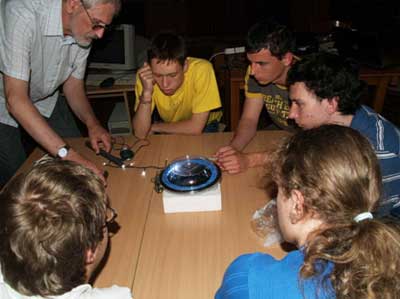
Building of cloud chamber (2010)
The project assignments given to the students also proved a success. Students in groups of 5-6 were asked to solve problems using the lecture materials, the equipment provided and the Internet. In the second year, students were asked to deliver a lecture on the main features and technological structure of a third-generation power-plant of their choice and to highlight the need for building new power plant units. Throughout the preparatory phase of their assignments students could ask the help of the guest lecturers. Guests were invited (playing the role of anti-nuclear energy activists) to attend the lectures given by students and some very interesting discussions developed on the necessity of nuclear power plants and the pros and cons of the various types of plants.
In the camps games and sports activities were also organised. Students played football, table-tennis and tennis and swam in an open-air pool. At the campsite bonfire very interesting conversations with the organizers and senior members of the Hungarian Nuclear Society took place. These activities were very popular with the students.
Nowadays, it is well-known that physics is not popular in schools. The universities complain about the level of the students. Their knowledge of physics is getting worse. A survey examining the general standard of students shows that those who took part is physics competitions or in further education programmes devoted to physics are more successful in the field. The HNS assists pupils who finished in the first three places in the Szilard Leo Competition7 (the main subject of the competition is atomic physics).
It is very important to support talented pupils. The consensus is that the summer camps were successful. They have achieved their objective. Participants grew to enjoy nuclear physics. It is a proven fact that a lot of former participants went on to study physics at university.
Some of the personal experiences at the summer camps were summarised by Kata Kovacs, who took part in all of the four summer camps.
“I am a first year student at the Budapest University of Technology and Economics, where I study physics. To me this camp means a lot because it is the place where I finally decided that I would like to study physics later on I would like to work in the nuclear industry. It was quite reassuring that every year different people did different jobs at establishments waiting for young physicists. I know that when I finish my studies I have a very good chance of finding a job from which I could earn enough money to keep my future family in financial security.
I also think these camps are very important because students get to hear about current issues which concern them and which future scientists will solve. In school, teachers usually teach from textbooks that are not up-to-date and there is no time set aside during the school year to talk about interesting, modern inventions or ideas. This camp is a place where participants hear about current issues and events in the world from professionals who are happy to answer questions too.
Every year there is an introduction to nuclear physics for those students who don’t have any knowledge of this field of physics. This introduction is held by Andras Mester, who uses a lot of illustrations to help the younger students understand. In this way, everyone can take an active part in all activities regardless of their age and former education. During the five days of the camp it’s very easy to learn a lot more than what is needed to pass the school leaving exams, which in Hungary are taken at the end of middle school.
The most important point for me is that I have been reassured that what I study now is hard, but is worth the effort because I will see a lot of benefits in the future. Also, as I have attended all four camps I have learned much more about the nuclear industry than I would have ever had a chance to at another place. As the middle school students from the camp finished their studies there were always a couple who decided to study physics at university, based on what they had seen at the camp.
This year I was the one who finally finished middle school and moved on to study physics at university. As I look back I think I wouldn’t have chosen physics if I hadn’t been to this camp. There are many reasons for it. First of all, most people don’t know what kind of job a person with a BSc or MSc (or PhD) in physics will get. Secondly, is that it is hard to pass the exams, so people need to be sure that it is worth the effort. Third, it’s not one of the most popular courses, so most students don’t even think about studying physics. This view exists only because people don’t know a lot about physics. At the camp all of these myths are dispelled, so the camp has great significance because it shows the future generation a path which they can follow.”
Andras Mester
Chairman of the Teacher's Expert Group of HNS
References:
www.szilardverseny.hu/
mnt.kfki.hu/Nukleon/
paksnuclearpowerplant.com/
mnt.kfki.hu/index.php?page=&lang=en
http://www.euronuclear.org/e-news/e-news-30/sck-cen.htm


SCK•CEN is a world-renowned partner in a global network of scientific institutions that has also earned international recognition as a research and training centre. It aims to create sustainable alliances with different types of partners. In recent months, SCK•CEN signed several cooperation agreements with research centres, companies and organisations in various countries, both inside and outside the European Union. It concerns the following research fields:
SCK•CEN signed a collaboration agreement with the National Nuclear Centre (NCC) of Kazakhstan and Kazatomprom. The NCC employs close to 2,700 researchers and consolidates six of Kazakhstan’s research centres. This collaboration agreement particularly concerns the MYRRHA project, which from 2023 will contribute to the development of solutions in the fields of nuclear energy and medicine, industry and renewable energies. This signing comes a few weeks after the signature of a similar agreement with China. These conventions constitute the first step towards the Asian countries’ probable entry into the MYRRHA consortium, 70% of which has to consist of member countries of the European Union.
This year it will be exactly 35 years since SCK•CEN signed its first “contract of association,” joining the “Association Euratom-Belgian State on Fusion Research.” On the occasion of this 35th anniversary, SCK•CEN will organise a topical day to look back at past R&D efforts in the field of fusion before looking to the future of this interesting research area. This topical day takes place on December 7 (see info on our website). SCK•CEN also signed earlier this year the renewed Trilateral Euregio Cluster (TEC) agreement, with FOM in the Netherland and FZJ in Germany. The agreement focuses on the plasma-wall interaction studies, for which SCK•CEN started a few years ago to carry out specific R&D thanks to its "VISION I" plasma simulator.
In the spring of 2009, Belgium decided to participate in the three most important projects of the International Broader Approach agreement for fusion (BA). This BA is an agreement signed between the European Union and Japan, within the framework of the decision to implement the ITER project in Europe. It comprises mostly three main programme lines:
The IFMIF/EVEDA project (International Fusion Material Irradiation Facility /Engineering Validation and Engineering Design Activities
The JT60 Super Advanced Project (Japan, Tokamak)
The IFERC Project (International Fusion Experimental Research Centre)
Within Europe, participation in the activities of the BA is based on voluntary contributions from several Members States, of which Belgium declared officially its desire to participate in 2007 and confirmed its contribution in 2009.
As coordinator of the BA, SCK•CEN recently signed two important contracts. One concerns a major agreement with ALM in Sclessin (Ateliers de la Meuse SA). ALM will produce a cryostat, a large stainless steel tank that can maintain internally very low temperatures (-269 ° C), while the outside remains at room temperature. The tank will be used to carry out cold tests on very strong superconducting magnets for the JT-60 SA Tokamak in Japan. The tests will be conducted at the CEA in France. ALM will also be responsible for the production of specialized accessories, including the system of vacuum pumps. This firm was chosen for its expertise and experience in creating similar smaller cryostats and vessels for very high vacuums, in particular for the CERN. The Belgian industry is well-respected for its expertise in and realisation of such advanced technologies. It is possible that in the future SCK•CEN and ALM will take part in other international programmes.
The other contract was signed with IBA (Ion Beam Applications - Louvain-la-Neuve). IBA will design and supply radio frequency power amplifiers for feeding an extremely powerful particle accelerator for the IFMIF facility. IFMIF will be used to test materials that can withstand the specific conditions in a future fusion reactor. The current contract concerns the building of a prototype accelerator over the next few years, in Japan. IBA was chosen because of its recognised expertise in the field of particle accelerators and similar experience in the production and delivery of power supplies for accelerators of different sizes. In this case, IBA will provide for the first time a radio frequency power supply for a linear accelerator with superconducting accelerating cavities. This involves the application of advanced technologies, in which our country and our industries have an excellent reputation and for which their expertise is widely recognised. Participation in such an international programme of this size also provides SCK•CEN and IBA opportunities for technological development.
During a royal mission to Brazil SCK•CEN renewed its agreement (started in 2005) with the Comissão Nacional de Energia Nuclear (CNEN - the National Commission for Nuclear Energy) in Brazil. This cooperation involves the storage of radioactive waste, dosimetry (e.g. in nuclear medicine), reactor materials, fuel and radiation in the BR2 reactor. In addition, SCK•CEN will also be responsible for education and training and exchange of researchers and doctoral and postdoctoral students.
CEA (France), SCK•CEN (Belgium) and NRG (The Netherlands) signed a major position paper for the establishment of the ‘European Research Area of Experimental Reactors’ (ERAER – see article on this subject in this edition of ENS NEWS). This paper stresses the importance of cooperation and implementation of a clear policy roadmap for the activities in European research reactors. It emphasises the following necessary irradiation infrastructure for future nuclear research in this area:
Opportunities for materials and fuel testing to support reactor safety, plant life management, optimisation and innovation for current and future nuclear power reactors
Development of a flexible fast-spectrum irradiation facility in order to put Europe in a leading position in the worldwide search for the sustainable nuclear energy of tomorrow
Radioisotopes production for nuclear medicine, a major commitment to public health
In Europe, the first generation of research reactors is approaching the statutory end of its operational lifetime. Research reactors are the key to developing a new generation of power reactors with improved fuel economy and high-level waste reduction, for research into fusion technology and for the production of radioisotopes. Now it is time for a coherent European policy to define and implement industry standards, while taking into account the needs of citizens and maintaining a high level of scientific expertise.
This policy includes a medium and long-term roadmap for new European research reactors. CEA, SCK•CEN and NRG allocated the following main functions to their new reactors:
Reactor Jules Horowitz (Cadarache, France): a high performance materials testing reactor
MYRRHA (Mol, Belgium): a flexible fast-spectrum irradiation research facility
PALLAS (Petten, The Netherlands): a research reactor as the main European producer of medical isotopes
The above-mentioned reactor operators state that ERAER is the only way to maintain Europe’s leadership in the field of reactor technology and to secure energy supply and satisfy modern healthcare requirements.
For more information: see our website www.sckcen.be.
See also:
Highlights 2009 - Press Releases (mostly in Dutch and French) - News
info@sckcen.be
http://www.euronuclear.org/e-news/e-news-30/runermark-award.htm

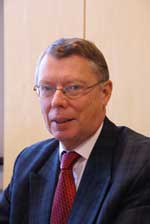 |
The Dutch Young Generation is delighted to say that Mr. André Versteegh has been chosen to receive the 2010 Jan Runermark Award. He was nominated by the Dutch Young Generation for his support during his entire career. André is founder and former director of the Nuclear Research and consulting Group (NRG) in Petten, the Netherlands. As director he gave the Young Generation the opportunity to organise ourselves and act as an independent organisation. André graduated in 1969 from Delft Technical University with a specialisation in Nuclear Engineering. After his graduation he started as |
|---|
business unit manager at Reactor Centrum Nederland (RCN). In 1985 he became programme leader Nuclear Energy at Energie Centrum Nederland (ECN).
In 1998 the nuclear research was split of ECN and André was the founder and director of this new company. He stayed at NRG till his retirement in 2010. Currently André is the president of NucNet.
Besides his work he had several international additional functions as board member in ENS, Foratom and NICE. At national level he was active in the board of Netherlands Nuclear Society (NNS), Kernvisie, ITER-NL and PINC (Conservation Nuclear Competence). He still is board member of stichting KINT (Knowledge Infrastructure Nuclear Technology).
During André’s career he always stimulated young people and the Dutch Young Generation to debate about nuclear energy as part of a safe, reliable and clean energy future. André often discussed with us at an inspired way and open for our opinion.
He has always been supportive with the organisation of lectures and congresses. The Dutch Young Generation is still thankful for his support with the organisation of the European Young Generation Forum which was held in Amsterdam in 2007.
The Jan Runermark award is the best way to thank André for his support to the Dutch Young Generation.
http://www.euronuclear.org/e-news/e-news-30/ygn.htm


Mr. Vincent de Rivaz, CEO of EDF Energy, was recently interviewed by Denis JANIN on behalf of the British and French Nuclear Young Generation Networks (NI/YGN and SFEN/JG). Mr de Rivaz , who’s a keen photographer, has recently been decorated with the French highest order the Légion d’Honneur. He kindly accepted our invitation to give his impression on several different topics ranging from the nuclear new build business in the UK to the French nuclear industry.
I joined EDF in 1977 as a fresh hydroelectric engineering graduate (Ecole Nationale Supérieure d'Hydraulique de Grenoble) and have spent my entire career within the group. My first position was in the External Engineering Centre which managed the construction of energy sites for international clients. I took part in several initiatives in Africa, Guyana and New Caledonia.
From 1985 I managed over seven years the Far East region for EDF. Our aim was to place EDF as a major international player in China. At that time, we were the first people to fly the EDF flag in China by developing projects in different areas of activity such as the nuclear, thermal and hydro generation sectors.
Between 1991 and 1994 I was the Managing Director of the Hydro Power Department. I then worked as the Deputy Head of the EDF International Division, creating and managing a new Projects Department. This enabled me in particular to be involved in the acquisition of London Electricity in 1998.
After a couple of years as the Head of Strategy and Finance for the EDF Group, I was appointed Chief Executive of the London Electricity Group in February 2002. This position enabled me to create EDF Energy in 2003 through the merger of former London Electricity Group and Seeboard. In January 2009, EDF Energy incorporated British Energy (BE) and I became the CEO of this company. EDF Energy, which is a wholly owned subsidiary of EDF group, is now one of the UK’s leading energy companies.
EDF Energy is the largest electricity company in the UK and has a unique position. We currently operate 15 nuclear reactors in the country and are ranked number one for electricity generation, and electricity distribution while leading on low carbon energy development.
We generate around one fifth of the UK's electricity, employ around 20,000 people, and deliver electricity to more than 8 million customer households and businesses. As a diverse but nevertheless integrated business, EDF Energy has two main plans for the future: the growth of our customer market share and the development of new nuclear power plants. In both endeavors, the fact of having incorporated British Energy (BE) will help us to achieve our ambitions.
First, BE’s eight existing nuclear power plants allow us to provide greater price certainty for our customers over the long-term, through the safe, reliable low carbon energy generated.
Secondly, following our coming together with British Energy, we also now own land where we plan to build new nuclear power stations, including Hinkley Point in Somerset and Sizewell in Suffolk. And with BE on board we now have all the skills, know-how, and relations that will help us drive new nuclear build in the UK. For example, BE has helped us to develop further our relations with the UK safety authority, supply chain partners and local communities which are all critical key partners in our new build business.
There are two main reasons which explain why the UK is now back to nuclear power. First, the UK’s current position on electricity generation: our 15 nuclear reactors are currently generating up to one fifth of the UK’s electricity demand and all but one of these reactors will be retired by 2023. Therefore it is necessary to build new nuclear reactors in order to replace the current ones.
The second reason is regarding carbon emissions. Since 2003, the UK government has implemented a strong policy to enhance the development of low carbon energies in order to reach its 2020 CO2 emission targets. This, coupled with the requirements of energy independence & security of supply prompted the government to include new nuclear power within the future energy mix.
As a result, it is suggested that nuclear power could represent up to 30% of the British energy mix in the long term and that the first of some 16 GWe of new generation plants are expected to be online in 2018. All of this will grow the share of nuclear energy in the UK’s energy mix from one fifth to one third – and that is a real challenge. However, I really think it is a fair and realistic target.
This is not really an issue. As you know, a coalition has been set up between the Liberal Democrats and the Conservatives and they are now governing the country together. What has emerged very quickly from the Coalition Government is clarity. In particular, clarity over its commitment to deliver a low carbon future, with a commitment that new nuclear energy will play a key part of the new Government’s plans.
The new Government’s energy policies have been set out in the Coalition Agreement, which was published shortly after the election. First, it proposes the introduction of a carbon price floor which will strengthen the focus on low carbon technologies. I have been a strong proponent of this policy over the last months as it represents a guarantee for operators to produce energy at a competitive price. Secondly, the Agreement made clear that new nuclear power is firmly on the new Government’s agenda.
Going forward, the construction of new nuclear power plants in the UK will be validated though a National Policy Statement which will be voted on in Parliament in due course. I have no doubt on the result of the vote. I am also reassured by the comments of Chris Huhne, the new Secretary of State for Energy and Climate Change, who has already said that he will take a pragmatic approach to new nuclear power although his Liberal Democrat party has opposed it in the past.
We would like to build four EPR reactors by 2025, which will represent half of the first wave of new build in the UK. We are developing a business case for each of them as all new nuclear reactors in the UK will be built without any public subsidy. We also would like to be the leader in this new build process.
Our main challenge is the massive recruitment of people. Because human capital has to match our capital investment. We have to recruit, train and retain the talent that we need at a large scale. As a result, we have for example, signed agreements with several universities in the UK to enhance specific training for the UK’s nuclear industry and we are set to recruit 10,000 people over the next five years to support our investment plans and renew our growing workforce.
The second biggest challenge is to work together within the EDF group as an international project. Development of the EPR is an international program. It is the combination of common practices, combined design & procurement with a focus on local adaptation. EDF cannot survive without global thinking however we have to “act local” to develop our projects. We need therefore to coordinate our workforce at every level in order to reach our targets.
We are scheduled to pour the first concrete at Hinkley Point in 2013. That means all licensing will have to be completed before the end of 2011. In this certification process, we are working in close collaboration with our partner Areva and we are, to date, making good progress past every milestone together. Currently, our local public consultations are also progressing well. We are working hard to consult and engage with the local community on our plans for new nuclear build.
At the same time, we have already taken steps to prepare the supply chain required for our new build plans. We are working not only with international suppliers on our projects but also with national and local suppliers. Today, we have already placed in excess of 40 contracts with UK’s suppliers.
Regarding FL3 feedback, we will learn a lot in Flamanville. But as I previously said, the EPR is a program. It must be understood as a whole. We have a series of EPRs which are going to be built in China, the UK and in France (FL3, and Penly). It allows us to combine all these projects as a big one whilst at the same time adapting to local constraints. This is what is making the project so exciting.
Nuclear power is a success story in France. Having 58 reactors supplying more than 400 TWh is a huge competitive asset for EDF and for France. The development of these reactors has been a great achievement for both EDF and Areva (Framatome) and this is why electricity prices are more stable and quite low in France.
However, the future of the nuclear industry is international. Therefore, we need to review our business model, evolving our practices. Whilst we will need to reform our way of working, we will build on the strength of our existing experience, and above all, continue to work together.
Here in the UK, EDF Energy has taken the lead in the nuclear new build development. We are proud to play this role even if it entails great responsibilities. Our relationship with Areva is excellent: the design application of the EPR has been submitted jointly and we are continuing our work as we progress step-by-step towards certification.
As for the current issues in France, all I can say is that it would be welcomed to see EDF and its main partners, including Areva, align their positions both in France and abroad and strengthen their relations based on mutual respect. I am confident that this wide pragmatic approach will prevail.
Nuclear industry is a people business. All its success relies entirely on the quality of people. From researchers to engineers, managers or operators, at all levels, everybody has a part to play in this challenging human adventure.
Now, when we are recruiting and training many young people, the nuclear industry is providing huge opportunities for the Young Generation. But those opportunities also bring responsibilities - young people will need to ensure our focus on safety is unerring.
Another main responsibility for the next Generation is to break down some of the myths which still surround the nuclear energy. Nuclear power is a low carbon energy which has suffered from a bad image in our society for a long time. Nowadays this is starting to change and nuclear energy is no longer seen as a world of darkness and secrecy. The next generation will have to continue to show that the nuclear industry is open and transparent. In the meantime we have to accept that nuclear is only part of a diverse mix and that there are other options. We need to be rigorous in our openness, to convince the public, but not to impose on them.
As members of the Young Generation Networks, your aim should be to make the nuclear industry an inspirational industry for people as they plan their careers.
Regarding nuclear new build, we are facing a challenge not undertaken by anyone else in the business before. We have set the “nuclear renaissance” in theory. It’s now time to make it real and this is a challenge which has to be undertaken by passionate, focused and talented young professionals.
Other interviews of nuclear top managers are available on the SFEN-JG website: www.sfenjg.org/Interviews-de-dirigeants
http://www.euronuclear.org/e-news/e-news-30/yg-austria.htm

Up until the 1970s Austria was, like most other European countries, a state eager to develop and use nuclear technologies. The Austrian government, therefore, started to build a NPP –the BWR at Zwentendorf. The plant was finished in 1978. The fuel was already on the site, when the Western Europe anti-nuclear movement reached Austria, and people started questioning the safety of nuclear energy. The Chancellor at the time, Bruno Kreisky, decided to call a referendum on whether or not to start up Zwentendorf NPP. He was a huge promoter of the NPP, and announced that he would retire if the result was negative. The opposition, which was also pro–nuclear, used the chancellor’s statement to decrease the political influence of his party. So, this had a significant impact on the result. In the end 50.2 % of the population voted against Zwentendorf NPP, and the plant never became operational.
The Austrian Nuclear Society (Österreichische Kerntechnische Gesellschaft - ÖKTG) was founded in 1980 with the aim of starting up Zwentendorf NPP, which had been kept open awaiting further political decisions. In 1986, a new referendum was scheduled, but due to the Chernobyl accident it never took place. From this time on the ÖKTG tried to provide unbiased information on all nuclear topics.
After the year 2000, a few young people, who were strongly supported by the ÖKTG Chairman, Professor Helmuth Böck, became interested in nuclear technologies. The Young Generation was then founded in 2006, by Otmar Promper. The main purpose was to provide students with unbiased information about nuclear technologies. The group grew steadily and also young professionals joined our society. Today, we count around 50 members under the age of 35; many of them are still at university studying - mostly nuclear physics, electro-technical engineering, mechanical engineering, process technology or related subjects. The young professionals work mainly at AREVA, Westinghouse, the research centre Seibersdorf or at the IAEA.
As the group got bigger, the focus changed. Today, we don’t only provide information to our group, but we are also trying to build a network of experts to answer questions related to nuclear technologies. We try to change the attitude towards nuclear technologies in Austria.
We are quite active, also within the ENS-YGN. At the beginning of September 2010, we organised an excursion to Olkiluoto, Finland. This visit was organised in cooperation with the Finnish YGN. 15 of our members participated. The journey started on 6 September, with a flight from Vienna to Helsinki. From there we continued by train and bus to Rauma. On Tuesday morning a TVO bus took us to the island of Olkiluoto, where the two existing NPPs Olkiluoto 1 and 2, as well as the new EPR, are situated. Nearby on the same island, there is also a storage for spent fuel, as well as a final repository for low and medium-level waste.
The finish YGN gave an overview of the on-going projects there, on TVO as whole, and the two existing plants OL1 &2. After lunch we had a guided tour through the OL1 plant. It was a very detailed visit of the plant: We were taken to the workshops and the turbine hall, where we were told that TVO had recently changed the low-pressure turbine in OL2 and that they will also change it soon in OL1. Finally, we went to the reactor hall. From the reactor hall-level downwards we were able to enjoy a nice view over the whole island by using a glass elevator. The planned visit to the spent fuel storage facility had to be cancelled, as there was on-going work there.
After a short break, we got a guided tour through the Visitors’ Centre. One of the focuses was on the final waste repository and another on the OL3 project. We concluded the day with presentations from the Austrian side; we presented the history of the ÖKTG and also talked about the current situation in Austria. The evening was organised by our Finnish host. We spent some time together at the sea-side.
The next morning started again with presentations, this time about the OL3 and the OL4 projects. After an early lunch we finally visited the OL3 – building site and walked around the construction area, guided by the future operators of the plant. The tour included a detailed visit to the turbine hall, which is almost finished. After that, we were allowed to go to the final repository of the low and medium-level waste. It was built 60m underground, in the rockbed of Olkiluoto island. We saw the two silos where the waste is stored, as well as part of the project for the final repository for spent fuel. Two presentations about final waste management concluded the technical visit. In the evening we went back to Helsinki for some sightseeing the next day.
To summarise the journey, it was a very well organised trip. The Finnish YGN did a great job. For us it was very interesting to see the development in the reactor design. Many of us work in German NPPs, and so we could compare the changes and the improvements with the Konvoi – NPPs.
Another activity was the organisation of the 3rd Core Committee Meeting of the ENS-YGN, in Vienna. It took place from 17 - 19 of September and we welcomed 22 participants from all over Europe to the meeting. The agenda included three technical visits: one to the IAEA, where we were able to visit the Incident and Emergency Centre, as well as visits to two Safeguards Laboratories. The second tour was to the TRIGA Mark II Research Reactor at the Technical University of Vienna and the third was to the Zwentendorf NPP. The whole visit was a great success.
In the near future we are going to visit Austrian schools to present the subject of radioactivity and nuclear technologies to students as the subject is currently either avoided or only briefly touched upon by the teachers. These schools can later on also book a tour of the university’s research reactor, where they will even be able to do small experiments and measure radioactivity. For next year we are planning an excursion to Chernobyl.
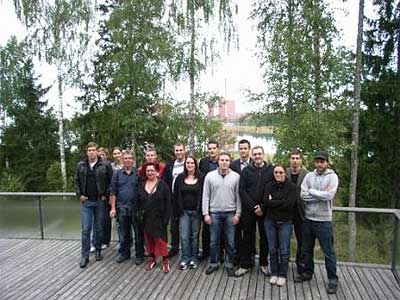
Eileen Radde, eileen.radde@oektg.at www.oektg.at
http://www.euronuclear.org/e-news/e-news-30/nucnet-news.htm


09.11.2010 - No. 201 / News in Brief
IEA’s 2010 Outlook Report Highlights Nuclear Growth Potential
9 Nov (NucNet): The share of nuclear energy in world primary energy demand could increase from six percent in 2008 to eight percent in 2035 if governments stick to the broad energy policy commitments they have made, says the International Energy Agency’s latest ‘World Energy Outlook’.
This would mean an annual growth rate for nuclear of 2.2 percent, more than any other single energy type, the report says. Under this ‘New Policies Scenario’ coal would grow by 0.6 percent, oil by 0.5 percent and gas by 1.4 percent. Hydro would grow by 2 percent and biomass and waste by 1.7 percent.
The report, released today, assumes that government policies will boost nuclear energy in several countries and that a growing number of countries implement programmes to renew the lifetimes of their existing nuclear plants, reducing capacity that would otherwise be lost to retirement of aging reactors.
Under an alternative ‘450 Scenario’, which seeks to stabilise the concentration of greenhouse gases at no higher than 450 parts per million (ppm) of CO2-equivalent (eq), renewables and nuclear would double their current combined share of total primary energy demand to 38 percent in 2035.
This scenario is based on The Copenhagen Accord, which established a non-binding objective of limiting the increase in average global temperature to two degrees Celsius above pre-industrial levels.
Cutting emissions sufficiently to meet the 2°C goal would require a far-reaching transformation of the global energy system, the report says.
“The timidity of current commitments has undoubtedly made it less likely that the 2°C goal will be achieved,” the report says. “Reaching that goal would require a phenomenal policy push by governments worldwide: carbon intensity — the amount of CO2 emitted per dollar of GDP — would have to fall at twice the rate of 1990-2008 in the period 2008-2020 and four times faster in 2020-2035.
“The technology exists today to enable such a change, but such a rate of technological transformation would be unprecedented. These commitments must be interpreted in the strongest way.”
The 450 Scenario describes how the energy sector could evolve were the 2°C goal to be achieved.
Meeting the goal would bring about a much faster transformation of the global energy system and a correspondingly faster slowdown in global CO2 emissions. Oil demand would peak just before 2020 at 88 million barrels per day, only four million barrels per day above current levels, and decline to 81 million barrels per day in 2035. Coal demand would peak before 2020 and demand for gas would peak before the end of the 2020s.
The report says world energy demand will grow by more than a third over the next 25 years, led by increased consumption in China.
In the New Policies Scenario, non-OECD countries account for 93 percent of the projected increase in global energy demand, reflecting mainly faster rates of growth of economic activity.
China, where demand has surged over the past decade, contributes 36 percent to the projected growth in global energy use, its demand rising by 75 percent between 2008 and 2035.
For more information see the World Energy Outlook 2010 website: www.worldenergyoutlook.org
Source: NucNet - Editor: david.dalton@worldnuclear.org
05.11.2010 - No. 44 / World Nuclear Review
EC Proposal Calls For ‘National Programmes’ On Final Disposal
5 Nov (NucNet): The European Commission this week proposed safety standards for disposing of spent nuclear fuel and radioactive waste that include asking member states to present national programmes showing when, where and how they will build and manage final deep geological repositories.
The Commission said it had adopted a proposal for a European Council directive calling for a legally binding and enforceable framework to ensure that all EU member states apply common standards for all stages of spent fuel and radioactive waste management up to final disposal.
The proposed directive, which covers waste from nuclear power plants as well as from medicine or research, calls for countries to draw up national radwaste programmes within four years of the adoption of the directive.
These programmes should include plans for the construction and management of disposal facilities, including a concrete timetable for construction.
EU member states will have to transpose the directive into national law within two years of adoption by the European Council, which is expected in 2011.
National programmes will then have to be presented within four years of adoption, which could mean the end of 2015.
Source: NucNet - Editor: david.dalton@worldnuclear.org
03.11.2010 - No. 197 / News in Brief
EC Proposal Calls For ‘National Programmes’ On Final Disposal
3 Nov (NucNet): The European Commission has today proposed safety standards for disposing of spent nuclear fuel and radioactive waste that include asking member states to present national programmes showing when, where and how they will build and manage final deep geological repositories.
The Commission said it had adopted a proposal for a European Council directive calling for a legally binding and enforceable framework to ensure that all EU member states apply common standards for all stages of spent fuel and radioactive waste management up to final disposal.
The proposed directive, which covers waste from nuclear power plants as well as from medicine or research, calls for countries to draw up national radwaste programmes within four years of the adoption of the directive.
These programmes should include plans for the construction and management of disposal facilities, including a concrete timetable for construction.
EU member states will have to transpose the directive into national law within two years of adoption by the European Council, which is expected in 2011.
National programmes will then have to be presented within four years of adoption, which could mean the end of 2015.
The Commission said two or more member states can agree to use a final repository in one of them, but reiterated that countries will not be allowed to export nuclear waste outside the EU for final disposal.
The directive would also see safety standards drawn up by the International Atomic Energy Agency become legally binding.
The Commission said that while low-level and medium-level radioactive waste is increasingly being taken care of, there is not yet a single final repository for high-level radioactive waste and spent fuel. It is likely, however, that the first such repositories will be opened between 2020 and 2025 in several EU countries.
The text of the proposed directive consists of proposals made by the European Nuclear Safety Regulators Group (Ensreg). Ensreg, a group of senior national nuclear regulatory officials, presented its suggestions for the content of the directive in June 2010.
Foratom, the Brussels-based nuclear energy industry group, said although quantities of radioactive waste are small compared to other toxic wastes, a legally binding text is important to ensure that all member states define and implement national programmes for the management of radioactive waste.
For more information on today’s announcement: ec.europa.eu
The text of the proposed directive is online: ec.europa.eu
Source: NucNet - Editor: david.dalton@worldnuclear.org
http://www.euronuclear.org/e-news/e-news-30/other-conferences.htm

17 - 19 November 2010
IAEA Headquarters Vienna, Austria
more
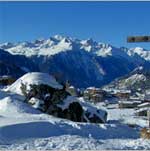
4 - 8 April 2011
Centre CNRS Paul Langevie, Aussois, France
more
![]()
16 - 19 May 2011
Makuhari, Chiba, Japan
more

4 - 9 September 2011
Nagoya, Japan
Atomic Energy Society of Japan
email: global2011@jaea.go.jp
more
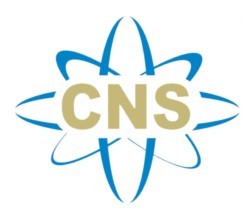
11 - 14 September 2011
Chinese Nuclear Society (CNS)
more
http://www.euronuclear.org/e-news/e-news-30/Member-Societies.htm

Austrian
Nuclear Society |
Belgian
Nuclear Society |
Bulgarian
Nuclear Society |
Croatian
Nuclear Society |
Czech Nuclear Society |
Finnish
Nuclear Society |
French
Nuclear Energy Society (SFEN) |
German
Nuclear Society (KTG) |
Hungarian
Nuclear Society |
The
Israel Nuclear Society |
Italian
Nuclear Association |
Lithuanian
Nuclear Energy Association |
Netherlands Nuclear Society |
The Nuclear Institute |
Nuclear
Society of Russia |
Nuclear
Society of Serbia |
Nuclear
Society of Slovenia |
Polish
Nuclear Society |
Romanian
Nuclear Energy Association (AREN) |
Slovak
Nuclear Society |
Spanish
Nuclear Society |
Swedish
Nuclear Society |
Swiss
Nuclear Society |
http://www.euronuclear.org/e-news/e-news-30/Corporate-Members.htm

Links to ENS Corporate Members
|
http://www.euronuclear.org/e-news/e-news-30/editorial.htm
Mark O’Donovan, Editor-in-Chief
Contributors to this Issue:
Adrian Bull (Westinghouse UK)
David Dalton (NucNet)
Kirsten Epskamp (ENS)
Denis Janin, (SFEN, YGN)
Andras Mester (HNS)
Dominique Mouillot (ONET Technologies)
Eileen Radde (YGN Austria)
Vladimir Slugen (ENS)
Andrew Teller (Areva)
Marek Sviták, (ČEZ Group)
Realisation:
Marion Brünglinghaus
Rue Belliard 65, BE-1040 Brussels
Phone +32 2 505 30 50 - Fax: +32 2 502 39 02
E-mail: info@euronuclear.org - http://www.euronuclear.org
The ENS News is a quarterly publication, in electronic
form only.
Copyright notice ©2010 European Nuclear Society.
Reproduction is authorised provided that the ENS News is acknowledged as the
source – except where otherwise stated.
![]()
© European Nuclear Society, 2010